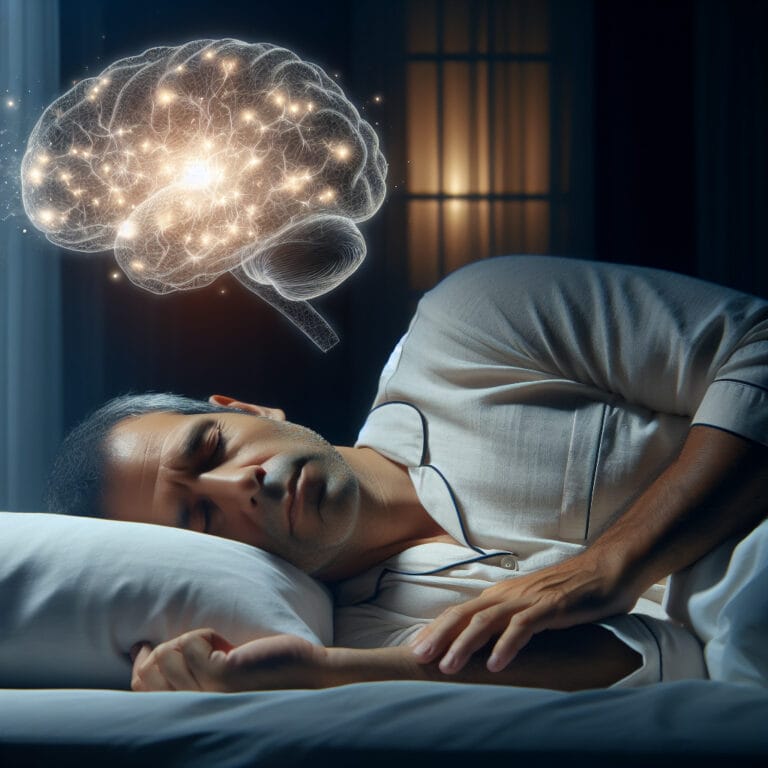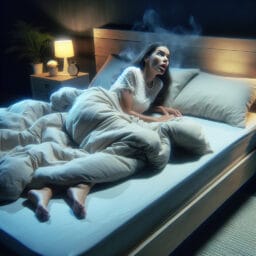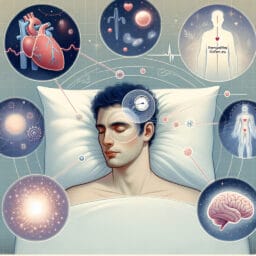
Understanding the Concept: What Does ‘Sleep Start’ Mean?
Table of Contents
- Introduction: Brief Overview of ‘Sleep Start’
- Definition of ‘Sleep Start’
- The Science behind ‘Sleep Start’
- Common Causes of ‘Sleep Start’
- Symptoms and Diagnosis of ‘Sleep Start’
- Treatment and Prevention of ‘Sleep Start’
- Conclusion: Recap of the Importance of Understanding ‘Sleep Start’
- Frequently Asked Questions
Introduction: Brief Overview of ‘Sleep Start’
An unexpected jolt or sensation of falling just as you’re drifting off to sleep is a phenomenon known as ‘sleep start’ or hypnic jerk. This common part of the sleep cycle might feel strange, but it’s typically harmless and merely a result of the brain transitioning from wakefulness to sleep. When you fall asleep, there’s a reduction in your brain activity leading to lighter stages of Non-Rapid Eye Movement (NREM) sleep before progressing to deeper REM stages where dreams occur. Sometimes, this transition isn’t seamless resulting in hypnagogic jerks that can disrupt your path to quality sleep. It’s estimated that 60-70% people will experience them at some point in their life, with its frequency varying widely among different individuals. Factors like stress, caffeine intake close to bedtime, and lack of proper sleep routine can increase occurrences of such sharp cries from our resting bodies. Understanding ‘Sleep Start’ is crucial because frequent sleep starts may indicate underlying conditions such as restless leg syndrome or other sleep-related disorders.
Definition of ‘Sleep Start’
Unraveling the mysteries surrounding ‘Sleep Start’ gives us a unique insight into how our brain functions during sleep. Technically termed as hypnic jerks, these involuntary muscle spasms occur just as you’re falling asleep and are considered a normal part of the sleep cycle. Interestingly, they differ from other sleep phenomena such as parasomnias or REM sleep behavior disorder that occur during deep stages of sleep. While hypnagogic jerks can disrupt your sleep, they typically happen in the lightest stage of Non-Rapid Eye Movement (NREM) sleep and do not lead to severe health issues unless excessively frequent. It’s important to understand that while many people experience this sensation at some point in their lives, experiences can vary widely based on factors like stress levels, caffeine intake before bedtime, irregular sleeping routines or underlying conditions resulting in poor quality sleep such as restless leg syndrome or obstructive sleep apnea. A regular overnight sleep study or maintaining a detailed ‘sleep diary’ can help track instances of frequent Sleep Starts and might also reveal other hidden patterns related to your sensory flash or visual dream occurrences.
The Science behind ‘Sleep Start’
As you navigate the path to slumber each night, your brain undergoes a dynamic dance of electrical activity. During the initial stage of light sleep, a sporadic burst might trigger a ‘Sleep Start’ or hypnic jerk – an involuntary muscle spasm that rudely rouses you from the edge of sleep. This common part of the REM cycle is typically harmless and is considered a normal part of transitioning between wakefulness and sleep stages. What stimulates these sudden jerks? The exact cause remains one of many mysteries surrounding our understanding of sleep but it’s believed to be due to irregularities in brain activity as your body unwinds from daily stimuli.
The tipping point where you’re asleep and awake is delicately balanced. If this equilibrium wavers, possibly due to stress or caffeine intake close to bedtime routine, our brains ability to smoothly transition between NREM stages can falter causing these sharp cries – ‘sleep starts’. While most individuals experience occasional hypnagogic jerks, frequent sleep starts may indicate underlying conditions such as restless leg syndrome or obstructive sleep apnea – essentially disrupting quality sleep.
Thus, maintaining a sleep diary for tracking abnormal sensory flash or visual dream events could provide invaluable insights into your sleeping patterns. In some instances where disruptions are regular , seeking professional guidance via an overnight sleep study could help address any potential deep-rooted issues guaranteeing further peace in your nightly rest.
| Term | Description | Possible Cause | Possible Indication |
|---|---|---|---|
| ‘Sleep Start’ or Hypnic Jerk | An involuntary muscle spasm that occurs as you’re falling asleep | Irregularities in brain activity during transition from wakefulness to sleep | Normal part of REM cycle, but frequent occurrences may indicate underlying conditions |
| REM Cycle | A phase of sleep characterized by rapid eye movement and dreaming | N/A | N/A |
| NREM Stages | Non-rapid eye movement sleep stages. Transition between these stages can be faltered due to stress or caffeine intake | Stress, caffeine intake close to bedtime | Disrupted sleep, ‘Sleep Starts’ |
| Restless Leg Syndrome | A condition characterized by an irresistible urge to move one’s body to stop uncomfortable or odd sensations | N/A | Frequent ‘Sleep Starts’ |
| Obstructive Sleep Apnea | A serious sleep disorder that occurs when a person’s breathing is interrupted during sleep | N/A | Frequent ‘Sleep Starts’ |
Common Causes of ‘Sleep Start’
Sleep Start, an intriguing phenomenon, is tied to various factors and can significantly impact one’s sleep quality. Stress and caffeine are common triggers for these hypnic jerks, disrupting the transition between awake and asleep states in your brain activity. A hectic lifestyle without a proper bedtime routine may result in sleep deprivation, further inducing Sleep Starts. On the other hand, a good medicine for healthy sleep habits is to create a calming environment promoting relaxation before you fall asleep.
Interestingly though, external influences aren’t the only culprits behind frequent Sleep Starts – your internal body clock plays an equally crucial role. The stage NREM sleep or lightest stage of your sleep cycle might hold clues about your susceptibility towards hypnagogic jerks. Moreover, underlying sleep-related issues like Restless Leg Syndrome or Obstructive Sleep Apnea that disrupt sleep can also lead to sharp cries from our resting bodies during early stages of slumber.
This intricate interplay between internal rhythms and external stimuli makes each individual’s experience with ‘Sleep Start’ vary widely affecting men, women, teens and children differently – unraveling more mysteries surrounding life sleeping patterns amongst different age groups! So if you’re plagued by frequent involuntary muscle spasms as youre asleep or experience excessive sleepiness during daytime- it might be beneficial to maintain a detailed ‘sleep diary’ to identify specific triggers or consult with professionals for an overnight sleep study.
| Factors | Effect on Sleep Start |
|---|---|
| Stress and Caffeine | Common triggers for hypnic jerks, disrupts the transition between awake and asleep states in brain activity. |
| Hectic Lifestyle and Lack of Routine | May result in sleep deprivation, further inducing Sleep Starts. |
| External Environment | A calming environment promotes relaxation before sleeping, reducing the likelihood of Sleep Starts. |
| Internal Body Clock | The stage NREM sleep or lightest stage of your sleep cycle might hold clues about your susceptibility towards hypnagogic jerks. |
| Underlying Sleep-related Issues | Conditions like Restless Leg Syndrome or Obstructive Sleep Apnea that disrupt sleep can also lead to Sleep Starts. |
| Age and Gender | Men, women, teens and children experience Sleep Starts differently, affecting their life sleeping patterns. |
| Involuntary Muscle Spasms and Daytime Sleepiness | May indicate frequent Sleep Starts. Keeping a ‘sleep diary’ or consulting with professionals may be beneficial. |
Symptoms and Diagnosis of ‘Sleep Start’
A case study on ‘Sleep Start’ lends credence to the intricacies of this sleep phenomenon. One patient appeared healthy but experienced frequent hypnic jerks, disrupted by sudden muscle spasms as they fell asleep. It was not just the act of falling asleep that was affected; their overall quality sleep suffered, leading to daytime fatigue and excessive sleepiness. The patient’s brain activity was assessed during an overnight sleep study, shedding light on their stage NREM sleep transitions. A surprising find was a heightened sensory flash during these transitions—each hypnagogic jerk accompanied by vivid visual dreams or hallucinations. Further investigation revealed an irregular bedtime routine and excessive stress—common triggers for these sharp cries from our resting bodies—as contributing factors.
Thus, diagnosing ‘Sleep Start’ involves assessing symptoms like intense hypnic jerk frequency, feelings of falling as youre asleep and correlating it with lifestyle patterns such as bedtime habits and stress levels. It’s indeed intriguing how our body signals us through frequent sleep starts about potential disruptions in our essential life sleeping routines!
Treatment and Prevention of ‘Sleep Start’
Navigating the mysteries of ‘Sleep Start’ and its causes opens pandora’s box of fascinating insights into our sleep cycle. Technically termed as hypnic jerks, these sensory flashes that occur as we fall asleep can disrupt the quality sleep we all need to lead a productive life. It’s not just an irregular bedtime routine or excessive caffeine intake close to bedtime that triggers these sharp cries from our resting bodies, but also underlying sleep disorders like Obstructive Sleep Apnea or Restless Leg Syndrome. However, the good news is that ‘Sleep Start’ is treatable and often preventable. A regular overnight sleep study or maintaining a detailed ‘sleep diary’ can help track instances of frequent Sleep Starts revealing patterns related to your brain activity during stage NREM sleep transitions. Remember, healthy sleep habits are the best medicine for preventing most sleep-related issues and ensuring you wake up feeling refreshed each morning.
Conclusion: Recap of the Importance of Understanding ‘Sleep Start’
Unraveling the mysteries surrounding ‘Sleep Start’, an intriguing sleep phenomenon technically referred to as hypnic jerks, provides fascinating insights into our sleep cycle. This common but often misunderstood experience of suddenly jerking awake just when you’re about to fall asleep is a result of the intricate dance of brain activity during our transition from wakefulness to slumber. Distinct from other sleep disorders, these sudden jolts are a part of the REM cycle and occur during the lightest stage – NREM stages – of your sleep. Triggers can vary widely among different individuals, with stress, irregular bedtime routine, caffeine intake and even underlying conditions such as restless leg syndrome or obstructive sleep apnea being linked to more frequent occurrences. Despite being generally harmless, frequent Sleep Starts can disrupt quality sleep leading to excessive daytime fatigue or hypersomnia – making it important for those plagued by constant hypnagogic jerks to consult with professionals for an overnight sleep study or maintain a detailed ‘sleep diary’. A better understanding of this complex interplay between internal rhythms and external stimuli is indeed crucial for ensuring healthy sleeping habits and addressing potential early signs of severe sleep-related issues.


